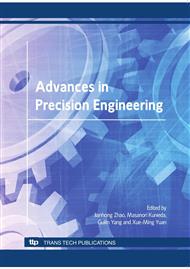p.91
p.96
p.101
p.106
p.111
p.116
p.121
p.126
p.131
A Study of Wear Characteristics of Superpolished Orthopaedic Implant Materials Using Ultra-Precision Polishing
Abstract:
Ultra-precision polishing is an emerging technology for producing superfinishing surfaces with sub-micrometer form accuracy and surface finish in nanometer range. It has been applied in superpolishing the freeform bearing surfaces of orthopaedic implants. It is believe that the superfinished surfaces are capable of prolonging the life of the implants. In this paper, an experimental investigation of ultra-precision polishing of orthopaedic implants and the study of the wear characteristics of the superfinished surfaces using a multi-directional pin-on-plate wear test simulator are implemented. Tests were carried out over 3 million cycles using Zeeko IRP200 superfinished cobalt chrome pins articulating against cross-linked UHMWPE plates. The results were compared to that of manually polished pins articulated against the same UHMWPE material. The results show that the Zeeko IRP200 polished pins produced better wear performance that that of the manually polished pins.
Info:
Periodical:
Pages:
111-115
Citation:
Online since:
September 2010
Authors:
Price:
Сopyright:
© 2010 Trans Tech Publications Ltd. All Rights Reserved
Share:
Citation:


